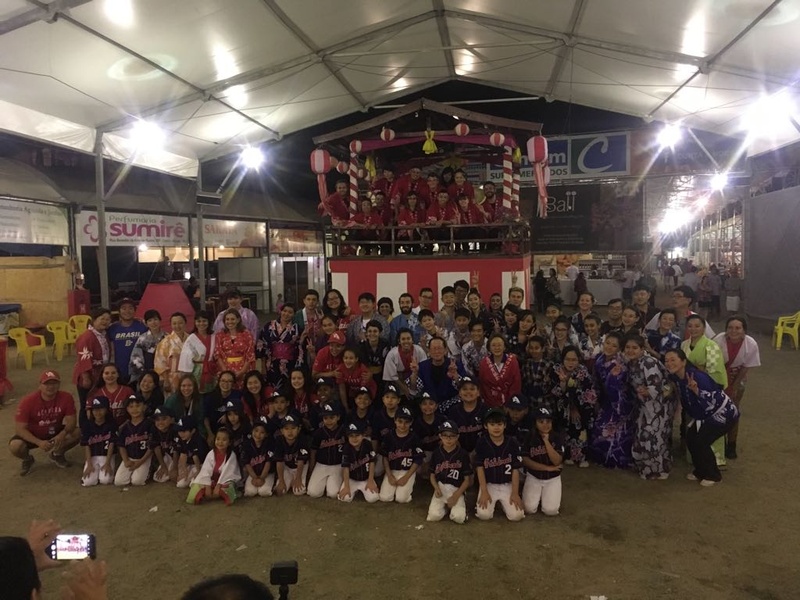Japan and the rest of the world are preparing for the highly anticipated 2020 Olympics in Tokyo. “Tokyo Gorin Ondo 2020”, the new version of the official song of the Tokyo Olympic Games, was released in early August and is performed by singers Sayuri Ishikawa, Yuzo Kayama and Pistol Takehara. The song's lyrics and choreography were recreated with the concept of Felicidade & Paz (“Happy & Peace”).
Gorin ondo ( gorin means “Olympic” and ondo is a genre of Japanese folk music) had great repercussions in Brazil, in the Japanese-Brazilian community, after a group of around 200 people danced the choreography together at the Flower and Strawberry Festival in Atibaia, in the state of São Paulo.
The emergence of the dissemination project
Closely linked to music, Tamiko Hosokawa, founder of the Bambu label, wants to gather the energy of Brazilian Nikkei and send that force to Japan.
Therefore, he asked for help from Mie Kato Yokomizo, 46 years old, whose home province is Aichi, who has been in Brazil with JICA (Japan International Cooperation Agency) for 11 years as a Japanese teacher at the association's Japanese language school. from the city of Atibaia, ACENBRA ― Japanese-Brazilian Sports Cultural Association of Atibaia.
Mie also carries out research for the publisher and soon accepted the invitation to support the promotion of ondo , as she thought it would be a good opportunity for Brazilians to learn about Japanese culture. Therefore, the Japanese teacher encouraged the taiko group Kawasuji Seiryu Daiko, of which she is a member, to participate in the dance as well.
Among the participants are also members of ACENBRA and Fukushima Kenjinkai, both children and adults. Of the total, 70% are Nikkei , with 80% of the participants in the association and the Atibaia taiko group being of Japanese descent. In the Fukushima Kenjinkai, curiously, the majority (80%) are non-descendants.
While the sensei feels proud to be part of such a large project, the Kawasuji players say they are “very honored”. “My friends said they felt happy and very excited,” says Mie.

Goals and plans
The project's objectives include informing people in general about the Olympics, dancing with people from different groups in Atibaia, living in harmony, having fun with friends, and making Brazil and Japan feel closer to each other. .
Therefore, it is important to show the Japanese organization the bon odori and Japanese culture in Brazil, in addition to the existence of the strong Japanese society in Atibaia.
The idea is for everyone to rehearse the choreography steps at home so they can all dance together at events. Therefore, one of the future plans of this project is to bring together 10,000 people to dance together to the official song of the Tokyo Olympics. The closing date is exactly 2020, the year of the Olympic Games in Japan.
And, for now, they intend to dance together in 2018 and there is the possibility of publicity during the celebration of 110 years of Japanese immigration in Brazil.
From Brasil to the world
This project shows the importance of promoting and preserving Japanese culture in Brazil, because it aims to reach Brazilians, Japanese and people from other countries.
By giving visibility to the sporting event, publicizing Ondo provides a different experience and encourages people to learn about the existence of other cultures, such as the diversity of Brazilian life and the richness of Japan's culture. Japanese).
In the announcement made in Atibaia, 60 people aged between 11 and 60 were from Kawasuji Daiko.
For the taiko group, “maintaining the culture means maintaining the roots. Our ancestors came to Brazil in search of dreams and brought with them the culture of the time in which they lived. And we descendants inherit this direct connection, in which we hear a lot that in our own country has been lost at some points. Preserving and promoting culture means, therefore, maintaining past roots, even more so here in Brazil.”
Kawasuji Seiryu Daiko
Kawasuji Seiryu Daiko is the Taiko group from the city of Atibaia (SP) created on October 12, 2002 with the arrival of professor Yukihisa Oda through JICA – Japan International Coorporation Agency. The name Seiryu means "clear waters", inspired by the name of the city of Atibaia, whose Tupi origin has the same meaning and the name Kawasuji represents the style used by the group.
Champion in 2005 in the Junior Category of the Brazilian Taiko Championship promoted by ABT, Kawasuji Seiryu Daiko was invited to perform at the 8th Junior Taiko Championship in Japan in 2006. Currently his school has around 60 members in four groups, including those who The current beginners in the art of taiko are already presenting themselves, with approximately half of them being Nikkei and the other half being non-descendants.
© 2018 Tatiana Maebuchi






